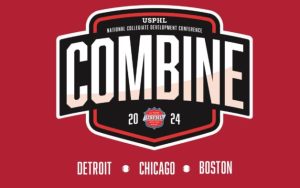AHU Coach’s Corner: Want to be a top-notch skater? Start utilizing sprints
 Advice from many sources is abundant, and often misleading.
Advice from many sources is abundant, and often misleading.
To understand how to prioritize offseason training, I wish every youngster could see up close an NHL practice and dryland workout. World-class hockey skills and athleticism are obvious in this setting, and they can be hidden by bulky equipment and game conditions when players are seen from the 30th row of an arena.
Stick skills and skating are exceptional and should never take a back seat to any other form of training. To develop as a player, it is not possible to spend too much time in these areas. Skating experts may not like the skating style of some players, but our tests over 30 years show that superior skating speed, agility and acceleration are required to play college or professional hockey. Besides unique mental qualities, NHL stars have superior multi-tasking abilities, putting skills and athleticism together at once, while their eyes and mind are busy making quick, creative decisions.
One of the most important athletic qualities is skating quickness. So here is an important fact — and there are not many invariant facts in exercise science: players who accelerate quickly on skates are also quick sprinters over a short distance. The shorter the sprint, the better the correlation to on-ice acceleration.
A recent published study concluded that the relationship between sprinting and skating speed was only valid at younger ages, but speeds were timed with a stopwatch. With all due respect, the authors might just as well have used a sun dial. I offer this acerbic, rather unprofessional criticism for one reason: kids would be misled if these conclusions were not challenged.
Besides mathematical probability, there is a remarkable similarity in the first few strides for both hockey players and football players. One difference of course: skaters must externally rotate their ankle and hip, but computer analysis verifies the two-dimensional similarity in biomechanics. After the first few strides, skating and sprinting become progressively different at higher speeds, and perhaps this is why coaches have failed to advise youngsters that sprinting is an important training tool.
As velocity increases, skating thrust is directed more to the side (so arm swing must also be across the body), while sprinting posture becomes more upright, and there are changes in the nature of force production. So the biomechanical similarity holds only for the initial acceleration, which is of course, most important for hockey.
Any hockey player, at any age, who wants to be a quicker skater should do quality short sprints. Longer sprints may be helpful in developing quick feet, and certainly sprinting is a good way to prevent hip flexor injuries. Allow plenty of rest, so each sprint is as fast as possible. Example: for a 30-meter sprint, allow 30-60 seconds rest — the more quality, the less endurance.
This is not just mathematical and biomechanical inference. In testing hundreds of players before and after significant skating improvement (over various periods of time) each one who showed improvement in sprinting acceleration also improved skating acceleration.
Sprinting is vastly underrated as a training tool, perhaps because it is not so easy to collect an exorbitant fee for this advice. This is an incredible oversight, because there is absolutely no other training modality that has such compelling statistical implications.
In plain English, skating quickness, agility and speed are essential for playing at a higher level, and there is no known off-ice training regimen that is as likely to improve skating quickness as quality, short sprints.
Is it best to combine this with hockey-specific leg strength and explosive power? And should skating practice be included?
Absolutely.
Kurt Goar is the coach-in-chief for the Arizona Hockey Club.
(Oct. 6, 2018)









